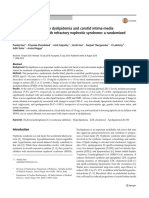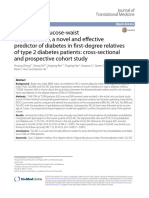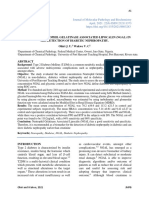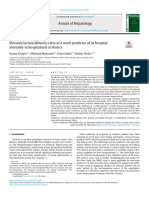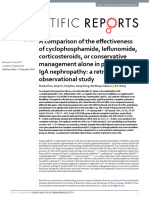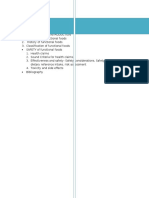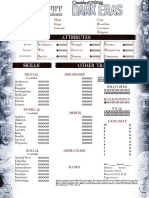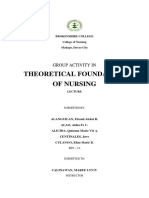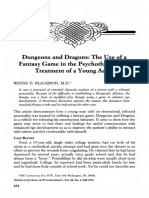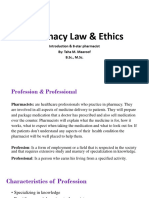Sindrom Nefrotik
Sindrom Nefrotik
Uploaded by
Dania SaraswatiCopyright:
Available Formats
Sindrom Nefrotik
Sindrom Nefrotik
Uploaded by
Dania SaraswatiOriginal Description:
Copyright
Available Formats
Share this document
Did you find this document useful?
Is this content inappropriate?
Copyright:
Available Formats
Sindrom Nefrotik
Sindrom Nefrotik
Uploaded by
Dania SaraswatiCopyright:
Available Formats
ORIGINAL RESEARCH
published: 20 June 2022
doi: 10.3389/fendo.2022.877794
Prognostic Value of Triglyceride
to High-Density Lipoprotein
Cholesterol Ratio (TG/HDL-C)
in IgA Nephropathy Patients
Gaiqin Pei 1,2†, Aiya Qin 1,3†, Lingqiu Dong 1,3, Siqing Wang 1,3, Xiang Liu 1,3,
Dandan Yang 1,3, Jiaxing Tan 3, Xiaoyuan Zhou 4, Yi Tang 3* and Wei Qin 3*
1 West China School of Medicine, Sichuan University, Chengdu, Sichuan, China, 2 Department of Rehabilitation Medicine
Center, West China Hospital, Sichuan University, Sichuan, China, 3 Department of Nephrology, West China Hospital of
Sichuan University, Chengdu, Sichuan, China, 4 West China School of Public Health, West China Forth Hospital of Sichuan
University, Chengdu, China
Edited by: Background: The triglycerides to high-density lipoprotein cholesterol (TG/HDL-C) ratio is
Nehal Mohsen Elsherbiny,
Mansoura University, Egypt
an easy-to-use atherogenic and prognostic marker which has attracted increasing attention
Reviewed by:
these days. However, whether TG/HDL-C correlate with outcomes in IgA nephropathy
Elena Rampanelli, (IgAN) patients remains unknown. To clarify these issues, we conducted this study.
Amsterdam University Medical Center,
Netherlands Methods: A total of 1146 patients from West China Hospital of Sichuan University were
Enrique Rodilla, retrospectively analysed between 2008 and 2018.The demographic, clinical and
Hospital de Sagunto, Spain
pathological data of all patients at the time of biopsy were collected. Then, patients
*Correspondence:
Yi Tang
were divided into the high TG/HDL group (TG/HDL ≥ 1.495, N=382) and the low TG/HDL
tmka1986@163.com group (TG/HDL-C < 1.495, N=764) based on the optimal cut-off value of the TG/HDL-C
Wei Qin using receive operating curve. Cox proportional hazard models and Kaplan–Meier curves
qinweihx@scu.edu.cn
†
were used to evaluate the renal outcomes of IgAN.
These authors have contributed
equally to this work Results: The median age of the patients was 33 (26-42) years, and 44.5% were men. By
correlation analysis, we found that the TG/HDL-C ratio was negatively correlated with the
Specialty section:
This article was submitted to
eGFR (r = 0.250, P < 0.001) but positively correlated with proteinuria (r = 0.230, P< 0.001),
Renal Endocrinology, BMI (r=0.380, P<0.001) and serum uric (r =0.308, P< 0.001). Patients with a higher TG/
a section of the journal
HDL-C ratio tended to have hypertension [odds ratio (OR), 1.987; 95% CI, 1.527-2.587;
Frontiers in Endocrinology
P<0.001] and more severe pathologic lesions with tubular atrophy/interstitial fibrosis (OR,
Received: 17 February 2022
Accepted: 17 May 2022 1.610; 95% CI, 1.203-2.154; P=0.001). During a median follow-up period of 54.1 (35.6-
Published: 20 June 2022 73.2) months, a high TG/HDL ratio was strongly associated with worse renal survival in
Citation: IgAN patients (log-rank: P <0.001). Multivariate Cox analysis demonstrated that a high TG/
Pei G, Qin A, Dong L, Wang S, Liu X,
Yang D, Tan J, Zhou X, Tang Y and
HDL-C ratio (HR 1.775, 95% CI 1.056-2.798; P=0.029) was an independent predictive
Qin W (2022) Prognostic Value of marker to ESRD.
Triglyceride to High-Density
Lipoprotein Cholesterol Ratio (TG/ Conclusion: In this study, we addressed the importance of TG/HDL-C ratio as a
HDL-C) in IgA Nephropathy Patients. predictive marker for IgAN progression.
Front. Endocrinol. 13:877794.
doi: 10.3389/fendo.2022.877794 Keywords: triglyceride, high-density lipoprotein cholesterol, IgA nephropathy, prognosis, TG/HDL-C ratio
Frontiers in Endocrinology | www.frontiersin.org 1 June 2022 | Volume 13 | Article 877794
Pei et al. TG/HDL-C and IgA Nephropathy
BACKGROUND TG/HDL-C ratio was obtained by dividing the serum triglyceride
level by the plasma high-density lipoprotein cholesterol level.
Immunoglobulin A (IgA) nephropathy (IgAN), characterized by Anemia, hypertension and hyperuricaemia was defined as
diffusely deposited IgA in the kidneys, is the most prevalent described previously (12, 13). eGFR was calculated using the
primary glomerulonephritis and a leading cause of end-stage CKD-EPI equation (14). Renal biopsy samples were evaluated by
renal disease (ESRD), in which 20–40% of IgAN patients reach an experienced pathologist and a nephrologist according to the
ESRD 10–20 years after the initial diagnosis (1). Recognizing risk Oxford classification (15)
factors of ESRD would be beneficial for to slowing the
progression of IgAN. Treatments
Abnormal lipoprotein metabolism, which could lead to All patients received optimal support treatment, including a full
impaired renal function and accelerated atherosclerosis (2), is dose of angiotensin-converting-enzyme inhibitor (ACEI) or
often characterized by the presence of high TG and low HDL-C angiotensin receptor blockers (ARBs). Glucocorticoids and
in chronic kidney disease (CKD) (3). It is well known TG usually immunosuppressant therapy included cyclophosphamide
increases in the early stages of CKD and is associated with (2 mg/kg daily for 3 months), mycophenolate mofetil (1-2 g
delayed catabolism. However, TG levels fluctuate substantially daily for 6-8 months), tacrolimus (0.03-0.05 mg/kg daily for 6-8
based on feeding status, thus limiting its utility as a predictive months) or cyclosporin was used based on pathological
biomarker (4). The single HDL-C, despite the functions of anti- classification and clinical severity according to the guidelines.
inflammatory and antithrombotic, remains controversial in
predicting cardiovascular disease (CVD) or mortality (5). The Outcome Definition
combination of TG and HDL-C, which is the TG/HDL-C ratio, The renal outcome was progression to ESRD, defined by
could therefore overcome the problem and has been proposed as commencement of renal replacement therapy or an eGFR <15
a more practical atherogenic and insulin resistance marker (6, 7). mL/min/1.73 m2.
It has attracted increasing attention for the better predictive
value for CVD (6, 8) and disease prognosis such as peritoneal Statistical Analysis
dialysis (7), coronavirus disease 2019 (9), type 2 diabetes (10), Continuous variables are expressed as the means ± SDs or
and CKD (11). However, whether the TG/HDL-C ratio could be medians (interquartile ranges). Categorical variables were
another predictor of IgAN progression remains unknown. To expressed as numbers and percentages (%). Student’s t test or
clarify these issues, we conducted this study. the Mann–Whitney U test was used for continuous variables,
and the c2 test was used for categorical variables. The optimal
thresholds of the TG/HDL ratio were obtained according to the
MATERIALS AND METHODS highest Youden’s index using receiver operating curve (ROC)
analyses. Kidney survival in each group was estimated by the
Patients Kaplan–Meier method. Univariate and multivariate Cox
A total of 1449 patients from West China Hospital of Sichuan proportional hazard models were used to evaluate renal
University between 2008 and 2018 were initially enrolled. progression of IgAN. Three statistical models were used in
patients with systemic disease, such as systemic lupus analysis: model 1 (demographics + pathological features + TG/
erythematosus, diabetes, Henoch-Schönlein purpura, liver HDL-C), model 2 (demographics + clinical features +TG/HDL-
cirrhosis or disorder of liver function, malignancy, etc., and C) and model 3 (demographics + clinical+ pathological
without complete clinical and pathologic data were excluded in features +TG/HDL-C). All the data were analysed by the
this study. Patients were followed up for at least 12 months or software package SPSS 23.0 software package (SPSS, Chicago,
until study-defined endpoints were reached. Finally, 1146 adult IL, USA) and GraphPad Prism 8.0. Two-tailed P<0.05 was
biopsy-proven IgAN patients (age > 14 years) were enrolled. The considered statistically significant.
research was in compliance with the Declaration of Helsinki and
was approved by the ethical committees of West China Hospital
of Sichuan University (2019-33). Informed consent was obtained RESULTS
from each patient or their legal guardians prior to treatment.
Demographic and Clinicopathological
Clinical Data Characteristics
Patient information, including age, sex, clinical manifestations, A total of 1146 biopsy-proven IgA nephropathy patients from
laboratory indexes, renal pathology reports, and treatment West China Hospital of Sichuan University were finally enrolled
strategies, systolic/diastolic blood pressure (SBP/DBP), body in this retrospective study (Figure 1). The demographic, clinical,
mass index (BMI) was obtained from electronic medical and pathologic characteristics of the included patients are shown
records. Laboratory values included 24-h proteinuria (UPRO), in Table 1. The median age of the patients was 33 (26-42) years,
hematuria level (URBC), hemoglobin (Hb), serum albumin and 44.5% were men. The median follow-up period was 54.1(35.6-
(ALB), serum creatinine (Cr), estimated glomerular filtration 73.2) months. ROC analysis revealed that the optimal cut-off TG/
rate (eGFR), uric acid (UA), triglycerides (TG), total cholesterol HDL-C ratio with which to predict the progression of ESRD
(TC), and high-density lipoprotein cholesterol (HDL-C). The in patients with IgAN was 1.495 (Supplementary Figure 1).
Frontiers in Endocrinology | www.frontiersin.org 2 June 2022 | Volume 13 | Article 877794
Pei et al. TG/HDL-C and IgA Nephropathy
Thus, according to their TG/HDL-C ratio at the time of renal
biopsy, patients were divided into two groups: a high TG/HDL-C
group (TG/HDL ≥ 1.495, N=382) and a low TG/HDL group
(TG/HDL-C < 1.495, N=764). The median eGFR in the high TG/
HDL-C and low TG/HDL-C groups was 9100.0 and 81.5 mL/
min/1.73 m2, respectively. Interestingly, higher SBP, DBP and
BMI levels were shown in the high TG/HDL-C group. Compared
with the low TG/HDL-C group, patients in the high TG/HDL-C
group had a higher incidence of anemia, hyperuricemia and
hypertension (all P <0.001), a higher proportion of males (P
<0.001), and worse renal function (P<0.001). Moreover, higher
levels of TG (P<0.001), TC (P=0.003), UPRO (P<0.001), and Cr
(P<0.001) and lower HDL-C (P<0.001) and URBC (P=0.009)
levels were observed in the high TG/HDL-C group. Regarding
pathological lesions, patients with a high TG/HDL-C always had
mesangial hypercellularity (P=0.06), segmental
glomerulosclerosis (P=0.053) and tubular atrophy/interstitial
FIGURE 1 | Flow diagram.
fibrosis (P=0.002).
TABLE 1 | Demographic and clinicopathological characteristics of 1146 IgAN patients.
Parameters Total N=1146 Group 1 (TG/HDL<1.495) N=764 Group 2 (TG/HDL ≥ 1.495) N=382 P
Age (year) 33 (26-42) 31 (25-41) 36 (27-44) < 0.001
Gender (male, %) 510 (44.5) 303 (39.7) 207 (54.2) < 0.001
HTN (%) 335 (29.2) 186 (24.5) 149 (39.2) < 0.001
SBP (mmHg) 125 (115-138) 124 (115-137) 128 (117-139) 0.012
DBP (mmHg) 82 (75-90) 80 (74-90) 84 (76-92) 0.004
BMI (kg/m2) 23.1 (20.2-25.6) 22.0 (19.6-24.7) 24.9 (22.3-27.6) < 0.001
CKD stages (%) < 0.001
Stage 1 615 (53.7) 455 (59.6) 160 (41.9)
Stage 2 290 (25.3) 178 (23.3) 112 (29.3)
Stage 3 202 (17.6) 118 (15.4) 84 (22.0)
Stage 4 39 (3.4) 13 (1.7) 26 (6.8)
Pathologic
M1 (%) 860 (75.1) 560 (73.3) 300 (78.5) 0.06
E1 (%) 52 (4.5) 35 (4.6) 17 (4.5) 1.00
S1 (%) 704 (61.4) 454 (59.4) 250 (65.4) 0.053
T1-2/T0 (%) 243 (21.2) 141 (18.5) 102 (26.7) 0.002
C1-2/C0 (%) 244 (21.3) 162 (21.2) 82 (21.5) 0.939
Clinical
Cr (umol/L) 83.3 (65.2-109.0) 79.0 (62.0-102.0) 93.8 (72.0-126.0) < 0.001
eGFR (mL/min/1.73 m2) 93.6 (66.0-117.7) 100.0 (71.8-120.1) 81.5 (54.9-105.5) < 0.001
ALB (g/L) 40.0 (36.0-43.1) 40.1 (36.0-43.2) 40.0 (35.8-43.0) 0.694
HDL (mmol/L) 1.39 (1.11-1.73) 1.54 (1.31-1.87) 1.07 (0.89-1.26) < 0.001
TG (mmol/L) 1.5 (1.1-2.1) 1.2 (0.9-1.5) 2.5 (2.0-3.4) < 0.001
TC (mmol/L) 4.8 (4.1-5.7) 4.7 (4.1-5.5) 5.0 (4.2-5.8) 0.003
UPRO (g/d) 1.5 (0.8-3.0) 1.3 (0.7-2.7) 2.0 (1.0-3.5) < 0.001
URBC (/HP) 18.0 (6.0-61.0) 19.5 (6.3-68.0) 15.0 (5.0-47.5) 0.009
Anemia (%) 161 (14.1) 88 (11.5) 73 (19.1) < 0.001
Hyperuricemia 466 (40.7) 262 (34.3) 204 (53.4) < 0.001
Treatment (%) 0.039
SC 438 (38.2) 307 (40.2) 131 (34.3)
GC only 432 (37.7) 289 (37.8) 143 (37.4)
IT and/or GC 276 (24.1) 168 (22.0) 109 (28.3)
Follow-up
Duration (months) 54.1 (35.6-73.2) 56.4 (36.3-75.1) 48.3 (34.7-67.6) < 0.001
ESRD 78 (6.8) 32 (4.2) 46 (12.0) < 0.001
Data presented as median (first-third interquartile range) or number (percentage).
SBP, Systolic Blood Pressure; DBP, diastolic blood pressure; BMI, body mass index; CKD, chronic kidney disease; M, mesangial proliferation; E, endocapillary proliferation; S, segmental
sclerosis; T, tubular atrophy/interstitial fibrosis; C, crescents; Cr, creatinine; eGFR, estimated glomerular filtration rate; ALB, albumin; HDL, high-density lipoprotein cholesterol; TG,
triglycerides; TC, total cholesterol; UPRO, 24 h urine protein; URBC, urinary red blood cell counts; SC, supportive care; GC, corticosteroids; IT, immunosuppressive therapy; ESRD, end
stage renal disease.
Frontiers in Endocrinology | www.frontiersin.org 3 June 2022 | Volume 13 | Article 877794
Pei et al. TG/HDL-C and IgA Nephropathy
Correlation of the TG/HDL-C
Ratio With Clinical Parameters and
Pathological Lesions
The correlations between the TG/HDL-C levels and
clinicopathological findings are illustrated in Tables 2, 3. Our
results showed that TG/HDL-C was significantly negatively
correlated with the eGFR (r = -0.250, P < 0.001) but positively
correlated with proteinuria (r = 0.230, P < 0.001), BMI (r=0.380,
P < 0.001) and serum uric (r =0.308, P< 0.001). Logistic
regression analysis was conducted to analyse the relationship
between TG/HDL and clinicopathologic features. The high TG/
HDL-C group IgAN patients were more likely to have
hypertension [odds ratio (OR), 1.987; 95% CI, 1.527-2.587;
P<0.001] and pathologic lesions with tubular atrophy/
interstitial fibrosis (OR, 1.610; 95% CI, 1.203-2.154; P<0.001)
and segmental sclerosis (OR, 1.293; 95% CI, 1.002-
1.670; P=0.049)
Renal Survival
During a median follow-up period of 54.1 (35.6-73.2) months, a
total of 78 (6.8%) patients developed ESRD. For renal survival,
our results reveal that TG/HDL-C ≥1.495 was significantly
associated with ESRD (Figure 2, P < 0.001). Subgroup analysis FIGURE 2 | Kaplan-Meier analysis for the endpoint of ESRD stratified by the
cutoff point of the TG/HDL-C.
of mesangial hypercellularity and tubular atrophy/interstitial
fibrosis, CKD stages and proteinuria for ESRD by Kaplan–
Meier analysis is shown in Figure 3. Our results indicated that
tubular atrophy/interstitial fibrosis (Figures 3E, F) in
a high TG/HDL-C ratio was a risk factor for ESRD in patients
pathologic lesions.
with IgAN, especially patients with eGFR<60 mL/min/1.73 m2
(P<0.001) (Figures 3A–C), 24-hour urine protein ≥1 g/day
(P< 0.001) (Figure 3D), or mesangial hypercellularity and TG/HDL-C as an Independent Risk Factor
for Progression of IgAN to ESRD
We performed Cox regression analyses to evaluate risk factors
TABLE 2 | Correlation between related variables and TG/HDL-C. for ESRD in patients with IgAN, which showed that a high TG/
HDL-C ratio was significantly associated with a higher risk of
Variables Correlation coefficient (r) P value
ESRD (HR=3.290, 95% CI: 2.093-5.173, P<0.001) in univariate
TG/HDL-C UPRO 0.230 < 0.001** analysis. Then, three models were used for multivariate Cox
Hb 0.034 0.254 regression (Table 4 and Supplementary Tables 1, 2), which
UA 0.308 < 0.001**
BMI 0.380 < 0.001**
indicated that high TG/HDL-C was an independent risk factor of
ALB -0.035 0.242 renal endpoints (model 1: HR 4.158, 95% CI 1.970-8.775,
eGFR -0.250 < 0.001** P<0.001; model 2: HR 3.944, 95% CI 1.825-8.523, P<0.001;
**stands for P < 0.01.
model 3: HR 1.775, 95% CI 1.056-2.798, P=0.029). Moreover,
UPRO, 24 h urine protein; Hb, hemoglobin; UA, uric acid; BMI, body mass index; ALB, when stratified by the quartiles of baseline level of TG/HDL-C as
albumin; eGFR, estimated glomerular filtration rate. Q1, Q2, Q3 and Q4 group (Supplementary Figure 2), significant
difference were also shown between Q4 (highest quartiles) and
TABLE 3 | Logistics regression models for the relationship between TG/HDL-C
other groups (Q1, Q2, and Q3)
and kidney pathologic lesion.
OR 95%CI P value
DISCUSSION
M 1.333 0.995-1.785 0.054
E 0.970 0.536-1.755 0.920 Dyslipidemia is common in China, with a prevalence of 41.9 %,
S 1.293 1.002-1.670 0.049*
and is commonly characterized by the presence of high TG and
T1-2/T0 1.610 1.203-2.154 0.001**
C1-2/C0 1.016 0.753-1.370 0.919
low HDL-C in CKD (16). Recently, the combination of TG and
HTN 1.987 1.527-2.587 < 0.001** HDL-C, the TG/HDL-C ratio, has attracted increasing attention
for its better predictive power for cardiovascular events and
*stands for P < 0.05, **stands for P < 0.01.
M, mesangial proliferation; E, endocapillary proliferation; S, segmental sclerosis; T, tubular insulin resistance than the lonely combination (17, 18).
atrophy/interstitial fibrosis; C, crescents; HTN, hypertension. Noticeably, several studies have shown a positively relationship
Frontiers in Endocrinology | www.frontiersin.org 4 June 2022 | Volume 13 | Article 877794
Pei et al. TG/HDL-C and IgA Nephropathy
A B C
D E F
FIGURE 3 | Subgroup Kaplan-Meier analysis for endpoint of ESRD; eGFR (A–C), UPRO (D), M (E), T (F); eGFR, estimated glomerular filtration rate; UPRO, 24 h
urine protein; M, mesangial proliferation; T, tubular atrophy/interstitial fibrosis.
TABLE 4 | Analysis of factors associated with renal outcomes in model 3 (demographics+ clinical indicators+ pathological features+ TG/HDL-C).
Parameter Univariate Multivariate
HR 95%CI P value HR 95%CI P value
high TG/HDL-C 3.290 2.093-5.173 < 0.001 1.775 1.056-2.798 0.029
male 1.902 1.213-2.982 0.005 – – –
Age (per year) 0.991 0.971-1.012 0.410 0.951 0.928-0.976 < 0.001
BMI (kg/m2) 1.048 0.956-1.149 0.319 – – –
SBP (mmHg) 1.033 1.022-1.044 < 0.001 – – –
DBP (mmHg) 1.049 1.034-1.063 < 0.001 – – –
M1 8.806 2.776-27.937 < 0.001 4.320 1.348-13.847 0.014
E1 2.232 1.073-4.642 0.032 – – –
S1 1.614 1.001-2.602 0.049 – – –
T1-2/T0 11.811 7.154-19.499 < 0.001 2.475 1.398-13.847 0.002
C1-2/C0 1.290 0.786-2.115 0.314 – – –
UPRO>1.0g 3.310 1.823-6.007 < 0.001 – – –
URBC>5/HP 0.947 0.559-1.605 0.840 – – –
Anemia 3.717 2.339-5.908 < 0.001 – – –
Hyperuricemia 4.457 2.778-7.573 < 0.001 – – –
hypoalbuminemia 2.255 1.302-3.907 0.004 – – –
CKD stages
CKD 2 vs 1 6.993 2.260-21.268 0.001 6.800 2.147-21.538 0.001
CKD 3 vs 1 30.497 10.970-85.394 < 0.001 23.898 7.714-74.031 < 0.001
CKD 4 vs 1 136.066 46.960-394.247 < 0.001 63.129 19.189-207.689 < 0.001
Treatment 0.010 0.036
GC/SC 0.738 0.414-1.317 0.304 1.191 0.705-2.011 0.514
IT/SC 1.710 1.019-2.869 0.042 0.563 0.319-0.992 0.047
SBP, Systolic Blood Pressure; DBP, diastolic blood pressure; BMI, body mass index; M, mesangial proliferation; E, endocapillary proliferation; S, segmental sclerosis; T, tubular atrophy/
interstitial fibrosis; C, crescents; UPRO, 24 h urine protein; URBC, urinary red blood cell counts; SC, supportive care; GC, corticosteroids; IT, immunosuppressive therapy.
between the TG/HDL-C ratio and renal function decline in CKD patients with IgAN was associated with more severe clinical
patients (16, 18–20). However, whether TG/HDL-C has a role in features and pathologic lesions. Our further analysis revealed a
IgAN progression remains unknown. higher serum TG/HDL-C level was an independent risk factor
In this study, 78 (6.8%) patients developed ESRD in our 1146 for the progression to ESRD (HR 1.775, 95% CI 1.056-
biopsy-proven IgAN patients. A higher TG/HDL-C ratio in 2.798, P=0.029).
Frontiers in Endocrinology | www.frontiersin.org 5 June 2022 | Volume 13 | Article 877794
Pei et al. TG/HDL-C and IgA Nephropathy
Previous studies have reported that the reduction in renal process (25, 26). Additionally, further tissue injury is contributed
function in patients is related to high TG/HDL-C levels (11, 16), owing to impaired HDL-mediated reverse cholesterol transport by
but no study has focused on IgAN patients. To our knowledge, limiting the unloading of the excess cellular cholesterol and
this is the first study assessing the correlation between the TG/ phospholipid burden (25). Thus, in the future, recognizing the
HDL-C ratio and ESRD in IgAN patients. Moreover, the TG/ TG/HDL-C ratio as a potentially modifiable risk factor for patients
HDL-C ratio has a greater influence in advanced IgAN patients may allow the utilization of preventative strategies to optimize both
(eGFR< 60 mL/min/1.73 m2) or these with 24-hour urine protein treatment and survival outcomes.
of ≥1 g/day in our study. This might be due to the slow Some limitations warrant consideration. First, this was a
progression of mild renal disease, especially within a limited retrospective study based on a single-center database. Second,
follow-up period (12). the median follow-up time of 54 months was relatively short.
Here, higher SBP, DBP and BMI levels were shown in the high Further multicenter validation in different ethnic populations
TG/HDL-C group. Further analysis showed TG/HDL was with longer follow-ups was needed.
positively correlated with BMI (r=0.380, P < 0.001). In our
multivariate Cox regression analyses, BMI was not independent
risk factor for renal progression. It is well known obesity often
result in excessive accumulation of energy, accompanied by CONCLUSION
abnormalities in lipid parameter levels. Some studies showed it
The TG/HDL-C ratio may be considered as a prognostic
was associated with the early development of hypertension and
biomarker in IgAN patients.
CKD progression (21). However, emerging epidemiologic
evidence indicated that obesity was not a direct and
independent risk factor for IgAN (22). It was possible that high
BMI indirectly accelerated the progression of IgAN by inducing DATA AVAILABILITY STATEMENT
metabolic syndrome on patients, in which TG/HDL-C is strongly
associated with it (23). Additionally, we would like to stress that The raw data supporting the conclusions of this article will be
high TG/HDL-C patients tend to have hypertension and more made available by the authors, without undue reservation.
severe renal pathologic lesions of segmental glomerulosclerosis
and tubular atrophy/interstitial fibrosis. Considering that
abnormalities in lipid parameter levels could accelerated ETHICS STATEMENT
atherosclerosis is plausible to believe that pathology of IgAN
patients with a high TG/HDL-C level. The studies involving human participants were reviewed and
Abnormalities in lipid parameter levels could lead to impaired approved by the ethical committees of West China Hospital of
renal function and accelerated atherosclerosis (2). TG usually Sichuan University (2019-33). The patients/participants
increases in the early stages of CKD and is associated with provided their written informed consent to participate in
delayed catabolism and decreased activity of hepatic TG lipase this study.
and peripheral lipoprotein lipase. However, based on feeding
status, TG levels could fluctuate substantially, thus limiting its
utility as a predictive biomarker (4). HDL-C, inversely associated
with outcomes, decreases in patients with CKD (11). The
AUTHOR CONTRIBUTIONS
combination of these two markers could therefore overcome this GP, AQ, SW, LD, XL, and DY collected and analysed the data.
problem and lead to a far more consistent, stable, fasting GP and AQ wrote the main manuscript text. YT, XZ and JT
measurement of dyslipidaemia, which has indeed attracted much reviewed and edited the manuscript. WQ supervised all the work
more attention in disease prognosis, including cardiovascular and revised the manuscript. All authors contributed to the article
disease (6), diabetes (10), and peritoneal dialysis (7). Here, the and approved the submitted version.
potential mechanisms by which the TG/HDL-C ratio serves as a
prognostic biomarker in IgAN patients may be as follows. TG/
HDL-C is a reliable indicator of insulin resistance, which induces
oxidative stress. Oxidative stress impairs the activation of nuclear FUNDING
factor erythroid-2-related factor-2, which protects against kidney
tissue injury (16). The filtered proteins, such as fatty acids, This study is partly supported by the National Key R&D
phospholipids, and cholesterol contained in the filtered proteins Program of China (2020YFC2006503) &(2020YFC2006500).
(albumin and lipoproteins), could include direct toxic effects of
lipids on glomerular cells and promote matrix production (3, 24).
Moreover, these materials act as damage-associated molecular ACKNOWLEDGMENTS
patterns (DAMPs) and are recognized by Toll-like receptors
(TLR2 and TLR4), which can activate inflammatory responses, We are indebted to all the people who kindly participated in
causing tubulointerstitial fibrosis and injury in the reabsorption this study.
Frontiers in Endocrinology | www.frontiersin.org 6 June 2022 | Volume 13 | Article 877794
Pei et al. TG/HDL-C and IgA Nephropathy
Supplementary Figure 1 | ROC curves (AUC) of TG/HDL-C for prediction of
SUPPLEMENTARY MATERIAL ESRD.
The Supplementary Material for this article can be found online
Supplementary Figure 2 | Kaplan-Meier analysis for the endpoint of ESRD
at: https://www.frontiersin.org/articles/10.3389/fendo.2022. stratified by quartile: Q1, first quartile; Q2, median; Q3, third quartile, Q4, fourth
877794/full#supplementary-material quartile.
(CHARLS). Lipids Health Dis (2021) 20:110. doi: 10.1186/s12944-021-
REFERENCES 01542-5
1. Rodrigues JC, Haas M, Reich HN. IgA Nephropathy. Clin J Am Soc Nephrol 17. Yu L, Zhou L, Zhou D, Hu G. Nonlinear Relationship Between Triglyceride/
(2017) 12:677–86. doi: 10.2215/cjn.07420716 High-Density Lipoprotein Cholesterol Ratio and Chronic Kidney Disease in
2. Florens N, Calzada C, Lyasko E, Juillard L, Soulage CO. Modified Lipids and US Adults: A National Health and Nutrition Examination Survey
Lipoproteins in Chronic Kidney Disease: A New Class of Uremic Toxins. Investigation. Int Urol Nephrol (2019) 51:2005–14. doi: 10.1007/s11255-019-
Toxins (Basel) (2016) 8:376. doi: 10.3390/toxins8120376 02287-y
3. Raikou VD, Kyriaki D, Gavriil S. Triglycerides to High-Density Lipoprotein 18. Wang X, Chen H, Shao X, Xiong C, Hong G, Chen J, et al. Association of Lipid
Cholesterol Ratio Predicts Chronic Renal Disease in Patients Without Parameters With the Risk of Chronic Kidney Disease: A Longitudinal Study
Diabetes Mellitus (STELLA Study). J Cardiovasc Dev Dis (2020) 7:28. Based on Populations in Southern China. Diabetes Metab Syndr Obes (2020)
doi: 10.3390/jcdd7030028 13:663–70. doi: 10.2147/dmso.S229362
4. Anderson JLC, Bakker SJL, Tietge UJF. The Triglyceride to HDL-Cholesterol 19. Ho CI, Chen JY, Chen SY, Tsai YW, Weng YM, Tsao YC, et al. Relationship
Ratio and Chronic Graft Failure in Renal Transplantation. J Clin Lipidol Between TG/HDL-C Ratio and Metabolic Syndrome Risk Factors With
(2021) 15:301–10. doi: 10.1016/j.jacl.2021.01.009 Chronic Kidney Disease in Healthy Adult Population. Clin Nutr (2015)
5. Vaziri ND. HDL Abnormalities in Nephrotic Syndrome and Chronic Kidney 34:874–80. doi: 10.1016/j.clnu.2014.09.007
Disease. Nat Rev Nephrol (2016) 12:37–47. doi: 10.1038/nrneph.2015.180 20. Tsuruya K, Yoshida H, Nagata M, Kitazono T, Iseki K, Iseki C, et al. Impact of
6. Reiner Ž . Hypertriglyceridaemia and Risk of Coronary Artery Disease. Nat the Triglycerides to High-Density Lipoprotein Cholesterol Ratio on the
Rev Cardiol (2017) 14:401–11. doi: 10.1038/nrcardio.2017.31 Incidence and Progression of CKD: A Longitudinal Study in a Large
7. Xia W, Yao X, Chen Y, Lin J, Vielhauer V, Hu H. Elevated TG/HDL-C and Japanese Population. Am J Kidney Dis (2015) 66:972–83. doi: 10.1053/
non-HDL-C/HDL-C Ratios Predict Mortality in Peritoneal Dialysis Patients. j.ajkd.2015.05.011
BMC Nephrol (2020) 21:324. doi: 10.1186/s12882-020-01993-5 21. Berthoux F, Mariat C, Maillard N. Overweight/obesity Revisited as a
8. Sultani R, Tong DC, Peverelle M, Lee YS, Baradi A, Wilson AM. Elevated Predictive Risk Factor in Primary IgA Nephropathy. Nephrol Dial
Triglycerides to High-Density Lipoprotein Cholesterol (TG/HDL-C) Ratio Transplant (2013) 28(Suppl 4):iv160–6. doi: 10.1093/ndt/gft286
Predicts Long-Term Mortality in High-Risk Patients. Heart Lung Circ (2020) 22. Wu C, Wang AY, Li G, Wang L. Association of High Body Mass Index With
29:414–21. doi: 10.1016/j.hlc.2019.03.019 Development of Interstitial Fibrosis in Patients With IgA Nephropathy. BMC
9. Alcá ntara-Alonso E, Molinar-Ramos F, Gonzá lez-Ló pez JA, Alcá ntara-Alonso V, Nephrol (2018) 19:381. doi: 10.1186/s12882-018-1164-2
Muñoz-Pé rez MA, Lozano-Nuevo JJ, et al. High Triglyceride to HDL-Cholesterol 23. Panwar B, Hanks LJ, Tanner RM, Muntner P, Kramer H, McClellan WM,
Ratio as a Biochemical Marker of Severe Outcomes in COVID-19 Patients. Clin et al. Obesity, Metabolic Health, and the Risk of End-Stage Renal Disease.
Nutr ESPEN (2021) 44:437–44. doi: 10.1016/j.clnesp.2021.04.020 Kidney Int (2015) 87:1216–22. doi: 10.1038/ki.2014.384
10. Orsi E, Penno G, Solini A, Bonora E, Fondelli C, Trevisan R, et al. Independent 24. Sieber J, Lindenmeyer MT, Kampe K, Campbell KN, Cohen CD, Hopfer H,
Association of Atherogenic Dyslipidaemia With All-Cause Mortality in et al. Regulation of Podocyte Survival and Endoplasmic Reticulum Stress by
Individuals With Type 2 Diabetes and Modifying Effect of Gender: A Fatty Acids. Am J Physiol Renal Physiol (2010) 299:F821–9. doi: 10.1152/
Prospective Cohort Study. Cardiovasc Diabetol (2021) 20:28. doi: 10.1186/ ajprenal.00196.2010
s12933-021-01224-7 25. Vaziri ND. Dyslipidemia of Chronic Renal Failure: The Nature, Mechanisms,
11. Kim Y, Lee S, Lee Y, Kang MW, Park S, Park S, et al. Predictive Value of and Potential Consequences. Am J Physiol Renal Physiol (2006) 290:F262–72.
Triglyceride/High-Density Lipoprotein Cholesterol for Major Clinical doi: 10.1152/ajprenal.00099.2005
Outcomes in Advanced Chronic Kidney Disease: A Nationwide Population- 26. Jialal I, Kaur H, Devaraj S. Toll-Like Receptor Status in Obesity and Metabolic
Based Study. Clin Kidney J (2021) 14:1961–68. doi: 10.1093/ckj/sfaa252 Syndrome: A Translational Perspective. J Clin Endocrinol Metab (2014)
12. Wang S, Dong L, Pei G, Jiang Z, Qin A, Tan J, et al. High Neutrophil-To- 99:39–48. doi: 10.1210/jc.2013-3092
Lymphocyte Ratio Is an Independent Risk Factor for End Stage Renal Diseases
in IgA Nephropathy. Front Immunol (2021) 12:700224. doi: 10.3389/ Conflict of Interest: The authors declare that the research was conducted in the
fimmu.2021.700224 absence of any commercial or financial relationships that could be construed as a
13. Al-Makki A, DiPette D, Whelton PK, Murad MH, Mustafa RA, Acharya S, potential conflict of interest.
et al. Hypertension Pharmacological Treatment in Adults: A World Health
Organization Guideline Executive Summary. Hypertension (2022) 79:293– Publisher’s Note: All claims expressed in this article are solely those of the authors
301. doi: 10.1161/hypertensionaha.121.18192 and do not necessarily represent those of their affiliated organizations, or those of
14. Stevens LA, Claybon MA, Schmid CH, Chen J, Horio M, Imai E, et al. the publisher, the editors and the reviewers. Any product that may be evaluated in
Evaluation of the Chronic Kidney Disease Epidemiology Collaboration this article, or claim that may be made by its manufacturer, is not guaranteed or
Equation for Estimating the Glomerular Filtration Rate in Multiple endorsed by the publisher.
Ethnicities. Kidney Int (2011) 79:555–62. doi: 10.1038/ki.2010.462
15. Trimarchi H, Barratt J, Cattran DC, Cook HT, Coppo R, Haas M, et al. Oxford Copyright © 2022 Pei, Qin, Dong, Wang, Liu, Yang, Tan, Zhou, Tang and Qin. This is
Classification of IgA Nephropathy 2016: An Update From the IgA an open-access article distributed under the terms of the Creative Commons
Nephropathy Classification Working Group. Kidney Int (2017) 91:1014–21. Attribution License (CC BY). The use, distribution or reproduction in other forums
doi: 10.1016/j.kint.2017.02.003 is permitted, provided the original author(s) and the copyright owner(s) are credited
16. Lv S, Zhang H, Chen J, Shen Z, Zhu C, Gu Y, et al. The Effect of Triglycerides and that the original publication in this journal is cited, in accordance with accepted
to High-Density Lipoprotein Cholesterol Ratio on the Reduction of Renal academic practice. No use, distribution or reproduction is permitted which does not
Function: Findings From China Health and Retirement Longitudinal Study comply with these terms.
Frontiers in Endocrinology | www.frontiersin.org 7 June 2022 | Volume 13 | Article 877794
You might also like
- The Encyclopaedia of Medical Astrology by Dr. Howard Leslie CornellDocument5 pagesThe Encyclopaedia of Medical Astrology by Dr. Howard Leslie CornellANTHONY WRITER38% (8)
- Fendo 13 885516Document7 pagesFendo 13 885516adri20121989No ratings yet
- Correlation Between Triglyceride Glucose Index and Severity of Coronary Artery Disease in Patients With Newly Diagnosed Coronary Heart DiseaseDocument6 pagesCorrelation Between Triglyceride Glucose Index and Severity of Coronary Artery Disease in Patients With Newly Diagnosed Coronary Heart DiseaseOeij Henri WijayaNo ratings yet
- Abstracts: Nephrology Dialysis TransplantationDocument1 pageAbstracts: Nephrology Dialysis TransplantationrezkyfikriNo ratings yet
- Ahead of PrintDocument5 pagesAhead of Printdoctor wajihaNo ratings yet
- JCH 12758Document6 pagesJCH 12758HanafieHeluthNo ratings yet
- Song 2012Document6 pagesSong 2012Yasser AlghrafyNo ratings yet
- Nutrients: Nutritional Adequacy and Latent Tuberculosis Infection in End-Stage Renal Disease PatientsDocument8 pagesNutrients: Nutritional Adequacy and Latent Tuberculosis Infection in End-Stage Renal Disease PatientsMarwa AmrangNo ratings yet
- Assessment of α1antitrypsin and α2macroglobulin levels in obese patientsDocument5 pagesAssessment of α1antitrypsin and α2macroglobulin levels in obese patientsAnnisa SufiNo ratings yet
- GA, 1,5 AG and HbA1cDocument7 pagesGA, 1,5 AG and HbA1cLegina AdityaNo ratings yet
- Jurnal Internasional Korea DMDocument9 pagesJurnal Internasional Korea DMzahradeswitamuftiNo ratings yet
- Hari 2018Document11 pagesHari 2018rahmansetiawanajaNo ratings yet
- IJCRT23A5059Document9 pagesIJCRT23A5059Agus SunardiNo ratings yet
- Comparison of Hba1C and Ogtt For The Diagnosis of Type 2 Diabetes in Children at Risk of DiabetesDocument7 pagesComparison of Hba1C and Ogtt For The Diagnosis of Type 2 Diabetes in Children at Risk of DiabetesAnnisa FujiantiNo ratings yet
- Content ServerDocument9 pagesContent ServerNourma Kusuma WinawanNo ratings yet
- Sodium and Potassium Intake in Overweight And.596Document2 pagesSodium and Potassium Intake in Overweight And.596jackie funtanillaNo ratings yet
- Kocyigit 2012Document8 pagesKocyigit 2012Rengganis PutriNo ratings yet
- Study of Platelet Aggregation in Subjects With Early Glucose Intolerance (EGI)Document5 pagesStudy of Platelet Aggregation in Subjects With Early Glucose Intolerance (EGI)Nestor TapiaNo ratings yet
- Translating The A1C Assay Into Estimated Average Glucose ValuesDocument6 pagesTranslating The A1C Assay Into Estimated Average Glucose ValuesFaryalBalochNo ratings yet
- JDR2019 7825804Document9 pagesJDR2019 7825804Anonymous Xc7NwZzoNo ratings yet
- Relationship Between C-Reactive Protein, White Blood Cell Count and Metabolic Syndrome in Nigerians With Type 2 Diabetes MellitusDocument11 pagesRelationship Between C-Reactive Protein, White Blood Cell Count and Metabolic Syndrome in Nigerians With Type 2 Diabetes MellitusPaul Gesswein FonatabaNo ratings yet
- Ijcem 0037903Document5 pagesIjcem 0037903riyanNo ratings yet
- Markers in Various Clinical Stages of Type 2 Diabetic Nephropathy" Merupakan Hasil SebuahDocument6 pagesMarkers in Various Clinical Stages of Type 2 Diabetic Nephropathy" Merupakan Hasil Sebuahkwon hyukNo ratings yet
- Jurnal Bu Sulis 1Document6 pagesJurnal Bu Sulis 1PitoAdhiNo ratings yet
- Jurnal PH 13Document9 pagesJurnal PH 13ruthameliapNo ratings yet
- SOS GH Predicts Mortality in ICU Schuetz EJE 2009Document7 pagesSOS GH Predicts Mortality in ICU Schuetz EJE 2009ediNo ratings yet
- E081727 FullDocument8 pagesE081727 FullOeij Henri WijayaNo ratings yet
- Mazidi 2017Document15 pagesMazidi 2017Anh Tho PHAMNo ratings yet
- Clinical, Hormonal, and Ultrasound Characteristics of Patients With Newly Diagnosed Graves' Disease and Different Thyroid Antibody ProfilesDocument8 pagesClinical, Hormonal, and Ultrasound Characteristics of Patients With Newly Diagnosed Graves' Disease and Different Thyroid Antibody ProfilesTeodorNo ratings yet
- Prevalence of Fatty Liver Disease Among Type 2 Diabetes Mellitus Patients and Its Relation To Insulin ResistanceDocument6 pagesPrevalence of Fatty Liver Disease Among Type 2 Diabetes Mellitus Patients and Its Relation To Insulin ResistanceKarina Winda BessufiNo ratings yet
- Adropin Subjects and MethodsDocument9 pagesAdropin Subjects and MethodsmariamzlaptopNo ratings yet
- Prognostic Value of Admission Blood Glucose in Diabetic and Non-Diabetic Patients With Intracerebral HemorrhageDocument7 pagesPrognostic Value of Admission Blood Glucose in Diabetic and Non-Diabetic Patients With Intracerebral HemorrhageNur Irma SafitriNo ratings yet
- Age +estimated+glomerular+filtration+rate+and+ejection+fraction+score+predicts+contrast-Induced+acute+kidney+injury+in+patients+with+diabetes+and+chronic+kidney+disease +insight+from+the+TRACK-D+studyDocument5 pagesAge +estimated+glomerular+filtration+rate+and+ejection+fraction+score+predicts+contrast-Induced+acute+kidney+injury+in+patients+with+diabetes+and+chronic+kidney+disease +insight+from+the+TRACK-D+studyangga_darmawan26No ratings yet
- Serum Ischemia Modified Albumin, Fibrinogen, HSCRP in DMT2 With and Without HypertensionDocument9 pagesSerum Ischemia Modified Albumin, Fibrinogen, HSCRP in DMT2 With and Without HypertensionMarcellia AngelinaNo ratings yet
- Risk Factors For Granulocytopenia in Patients With Graves' Disease Receiving Antithyroid DrugsDocument5 pagesRisk Factors For Granulocytopenia in Patients With Graves' Disease Receiving Antithyroid DrugsInterna UnhasNo ratings yet
- 67 Ej20-0159Document9 pages67 Ej20-0159desconocido 123 ambticonNo ratings yet
- Nihms 82233Document10 pagesNihms 82233LeonardoNo ratings yet
- Hofmaenner - Association Between Hypocholesterolemia and Mortality in Critically Ill Patients With Sepsis - A Systematic Review and Meta-AnalysisDocument10 pagesHofmaenner - Association Between Hypocholesterolemia and Mortality in Critically Ill Patients With Sepsis - A Systematic Review and Meta-AnalysisgiadungdanamallNo ratings yet
- Kosiborod Et Al.Document12 pagesKosiborod Et Al.LuluNo ratings yet
- Jdpo 3 4 299 303Document5 pagesJdpo 3 4 299 303NAMPEWO ELIZABETHNo ratings yet
- Dapaglifozina y Anemia en Enfermedad Renal Crónica NEJMDocument10 pagesDapaglifozina y Anemia en Enfermedad Renal Crónica NEJMDolores AlemánNo ratings yet
- DEVOTEDocument9 pagesDEVOTEDZGR NNNo ratings yet
- Triglycerides and Glucose Index A Useful Indicator ofDocument8 pagesTriglycerides and Glucose Index A Useful Indicator ofMyriam CardenasNo ratings yet
- Higado Graso No Alcoholico y Niveles de PCRDocument6 pagesHigado Graso No Alcoholico y Niveles de PCRperuliz19No ratings yet
- The Role of Neutrophil Gelatinase Associated Lipocalin (Ngal) in The Detection of Diabetic Nephropathy.Document7 pagesThe Role of Neutrophil Gelatinase Associated Lipocalin (Ngal) in The Detection of Diabetic Nephropathy.ijmb333No ratings yet
- RENA Study Cross-Sectional Study To Evaluate CKD Prevalence in PortugalDocument9 pagesRENA Study Cross-Sectional Study To Evaluate CKD Prevalence in PortugalsiilviasilvaNo ratings yet
- Albumin Ratio As A Novel PDocument6 pagesAlbumin Ratio As A Novel PSara VelezNo ratings yet
- Article 9Document10 pagesArticle 9vzwsvt7hgkNo ratings yet
- Hypoglycemia in Emergency Department: Journal of Acute DiseaseDocument4 pagesHypoglycemia in Emergency Department: Journal of Acute DiseaseMahdaNo ratings yet
- Journal of Clinical and Experimental CardiologyDocument5 pagesJournal of Clinical and Experimental Cardiologymelissa kristianaNo ratings yet
- Articulo 2Document7 pagesArticulo 2Gina GuisamanoNo ratings yet
- 7 FFCDocument8 pages7 FFCHow to youNo ratings yet
- 11 - Manoj Kumar MinjDocument8 pages11 - Manoj Kumar MinjIndah SarihandayaniNo ratings yet
- Joim 12116Document10 pagesJoim 12116mm3161No ratings yet
- Reconfirmation of Newly Discovered Risk Factors of Diabetic Peripheral Neuropathy in Patients With Type 2 Diabetes: A Case-Control StudyDocument10 pagesReconfirmation of Newly Discovered Risk Factors of Diabetic Peripheral Neuropathy in Patients With Type 2 Diabetes: A Case-Control Studychrisna dewiNo ratings yet
- Original Article Evaluation of Dyslipidaemia in Type 2 Diabetes Mellitus PatientsDocument6 pagesOriginal Article Evaluation of Dyslipidaemia in Type 2 Diabetes Mellitus PatientsEnvhy AmaliaNo ratings yet
- 2018 Article 31727Document11 pages2018 Article 31727Jackson HakimNo ratings yet
- Assessment and Treatment of Hyperglycemia in Critically IllDocument6 pagesAssessment and Treatment of Hyperglycemia in Critically IllYousif ElmasryNo ratings yet
- Elevated Triglycerides To High-Density Lipoprotein Cholesterol (TG/HDL-C) Ratio Predicts Long-Term Mortality in High-Risk PatientsDocument8 pagesElevated Triglycerides To High-Density Lipoprotein Cholesterol (TG/HDL-C) Ratio Predicts Long-Term Mortality in High-Risk PatientsIrwinNo ratings yet
- Hyperbilirubinemia: A Risk Factor For Infection in The Surgical Intensive Care UnitDocument14 pagesHyperbilirubinemia: A Risk Factor For Infection in The Surgical Intensive Care UnitChristian Karl B. LlanesNo ratings yet
- Complementary and Alternative Medical Lab Testing Part 6: Liver and GallbladderFrom EverandComplementary and Alternative Medical Lab Testing Part 6: Liver and GallbladderNo ratings yet
- Functional Foods and Its Safety - NFFDocument24 pagesFunctional Foods and Its Safety - NFFriaNo ratings yet
- Khyree HamelDocument4 pagesKhyree Hamelapi-547776760No ratings yet
- GNT Dmho 08082022Document7 pagesGNT Dmho 08082022harish sappaNo ratings yet
- Preboards 3 Nursing Practice 2 Nov 2021 PDFDocument12 pagesPreboards 3 Nursing Practice 2 Nov 2021 PDFBanana Q0% (1)
- VTR 2E Dark Eras 4 Page V2 InteractiveDocument4 pagesVTR 2E Dark Eras 4 Page V2 InteractiveEmme ElleNo ratings yet
- Penders Health Promotion ModelDocument7 pagesPenders Health Promotion ModelANIME SOLONo ratings yet
- 01.27.21 BNC MinutesDocument3 pages01.27.21 BNC Minutescambaro multipurposehallNo ratings yet
- City Ordinances Archive: This ScreenDocument116 pagesCity Ordinances Archive: This ScreenMARIENo ratings yet
- Dungeons and Dragons Use in TherapyDocument9 pagesDungeons and Dragons Use in TherapyAndreaNo ratings yet
- Full Ebook of Neuromodulation Comprehensive Textbook of Principles Technologies and Therapies 2Nd Edition Elliot S Krames Online PDF All ChapterDocument70 pagesFull Ebook of Neuromodulation Comprehensive Textbook of Principles Technologies and Therapies 2Nd Edition Elliot S Krames Online PDF All Chapterveronicakenney249074100% (6)
- Management and Administration of Intravenous Iron in Adults Under The Gastroenterology Directorate CA5180 v2Document13 pagesManagement and Administration of Intravenous Iron in Adults Under The Gastroenterology Directorate CA5180 v2Hector JaramilloNo ratings yet
- HCC AASLD Practice Guidance 2023Document104 pagesHCC AASLD Practice Guidance 202333newman33No ratings yet
- 1.02 Directional Terms and Anatomical Positions C.thorntonDocument26 pages1.02 Directional Terms and Anatomical Positions C.thorntonEthan StefanovNo ratings yet
- M209 - Challenges Converting From TMH 1 To SANS 3001 PDFDocument9 pagesM209 - Challenges Converting From TMH 1 To SANS 3001 PDFWise walukaNo ratings yet
- PASSAGE 4 - Green TeaDocument4 pagesPASSAGE 4 - Green TeaAmalina MohdNo ratings yet
- Safety Data Sheet: SECTION 1: Identification of The Substance/mixture and SupplierDocument10 pagesSafety Data Sheet: SECTION 1: Identification of The Substance/mixture and SupplierVasanthakumar VenkatesanNo ratings yet
- 5CC 2020 Virtual Conference Program PDFDocument29 pages5CC 2020 Virtual Conference Program PDFhuyenthanh1807No ratings yet
- Greene Et Al. 2018Document10 pagesGreene Et Al. 2018Elva NerizNo ratings yet
- Informing Speech OutlineDocument2 pagesInforming Speech OutlineMUHAMMAD HAIKALNo ratings yet
- Laboratory SafetyDocument28 pagesLaboratory SafetyWiza MulengaNo ratings yet
- After You'Ve Registered With: Track Your Progress After Your Assessment Using MygovDocument2 pagesAfter You'Ve Registered With: Track Your Progress After Your Assessment Using MygovSimran SekhonNo ratings yet
- CANTILEVER DENTAL BRIDGE حيدر حسين عليويDocument1 pageCANTILEVER DENTAL BRIDGE حيدر حسين عليويHayder HussienNo ratings yet
- News Story Public Event Draft PDFDocument1 pageNews Story Public Event Draft PDFFinn HurleyNo ratings yet
- PRICE LIST Dan Link E Katalog Java Update 22Document6 pagesPRICE LIST Dan Link E Katalog Java Update 22febyanzNo ratings yet
- Introduction & 8-Star PharmacistDocument14 pagesIntroduction & 8-Star Pharmacistphd0780No ratings yet
- Final Announcement PIT XXI & Konas XI PDS PatKLIn 2022 MakassarDocument23 pagesFinal Announcement PIT XXI & Konas XI PDS PatKLIn 2022 Makassarnina damayantiNo ratings yet
- Ruang Swara - Final AssignmentDocument31 pagesRuang Swara - Final Assignmentandre barmabiNo ratings yet
- Respiration 2 QPDocument11 pagesRespiration 2 QPShahzada Khayyam NisarNo ratings yet
- 9 Extra Exam Practice: Origami: More Than ArtDocument2 pages9 Extra Exam Practice: Origami: More Than ArtSoniaNo ratings yet











